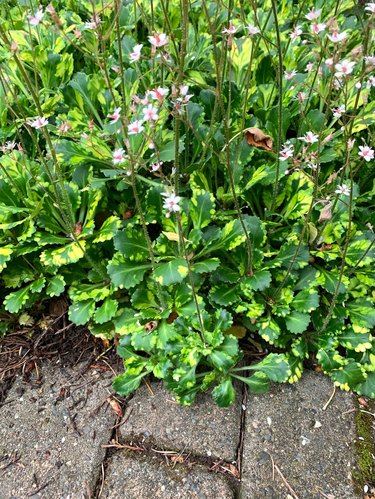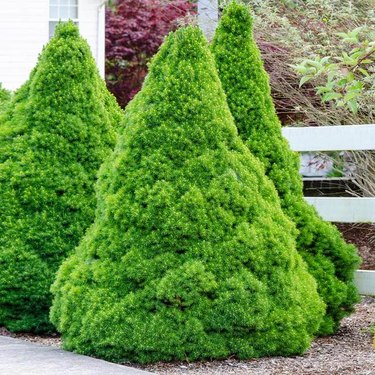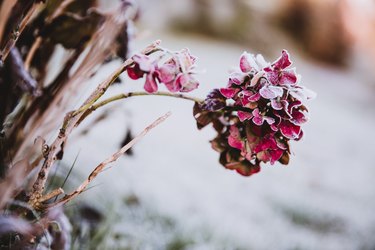
Most people think that gardens are just for the "growing season," meaning from some point in midspring to fall's first frost, when plants must be hardy to survive. Winter is not included and is considered a time to stay by the fire.
However, winter is arguably the season when people rely most on nature to provide a reminder that life continues. Plants can survive winter's worst cool weather and thrive, and so will we. That's why including cold-weather plants in your garden is so important.
Video of the Day
Video of the Day
When you consider adding plants that will survive winter weather, knowing your hardiness zone is of top importance. If you pick plants that thrive in your hardiness zone, they are very likely to survive your normal winter freezing temperatures. Be sure the plants you pick will not only make it through the winter but will also appreciate the exposure and soil you have to offer.
You may be surprised to learn that there are plants of all sizes that are winter hardy, including flowers that won't bloom in the winter but will survive the cold temperatures to bloom again the following spring. All of these choices are suitable for cold-winter climates.
5 Cold-Weather Ground Covers
Tricolor Caucasian Stonecrop

If you think of sedum as a warm-weather plant, you're right, but some sedum species are tough and tolerate cold winters. Tricolor caucasian stonecrop (Sedum spurium 'Tricolor') is a low-growing evergreen sedum that doesn't grow taller than 6 inches but spreads to a couple feet wide. It looks great as ground cover or in rock gardens. The thick leaves are green in the center with white margins tinged with pink. They turn deep burgundy in fall for overwintering. Tiny, star-shaped pink flowers appear densely from red flower stems in spring to summer. Plant it in USDA zones 3-9 in well-draining soil in full sun.
Golden London Pride
This saxifrage evergreen (Saxifraga × urbium 'Aureopunctata') is easy to grow and is very cold hardy, thriving in USDA zones 4-9. The plants grow their leathery leaves in rosettes that are dark green with gorgeous leopard-yellow spots. Look for baby-pink flowers to appear in spring and continue blooming through late summer. Golden London Pride is a good ground cover for shady areas, preferring light shade or full shade to sun. They grow to 12 inches tall and wide. For an alternative to a regular grass lawn, some ground overs work well, including this one.
Deadnettle

This perennial ground cover is not blessed with an appealing name, but deadnettle (Lamium maculatum) can be extremely attractive as well as hardy enough to thrive in USDA zone 3. It also can be considered for a lawn alternative in shady areas. Deadnettle offers lush, variegated leaves and cheerful flowers in dry, shady areas that are so tough to fill in any landscape, especially a cold one. Try the cultivar Lamium maculatum 'Beacon Silver' for silvery foliage and purple flowers.
Bearberry
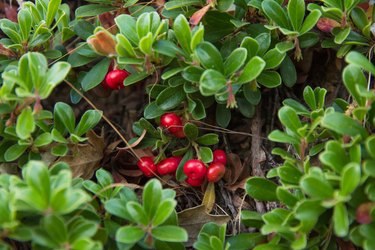
Short and incredibly sweet, bearberry (Arctostaphylos uva-ursi) offers exceptional perennial ground cover for cold winter areas down to USDA zone 2. The brilliant green foliage changes to bronze in autumn and winter. Spring blossoms are white and bell-shaped and develop into lipstick-red berries. They hang on the bushes into winter, nurturing wildlife and providing beauty for you.
Creeping Dogwood
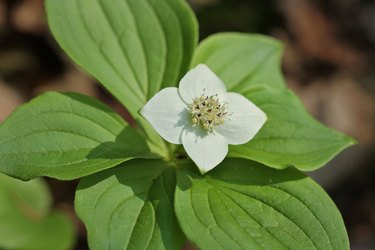
Gardeners in USDA hardiness zones 2-7 will enjoy creeping dogwood (Cornus canadensis), also known as bunchberry. It is an attractive ground cover with whorls of leathery green leaves that deepen into purple in the winter. It offers spectacular flowers in late spring through early summer that are white blushing pink and surrounded by six leaves. These mature into clusters of scarlet berries.
5 Cold-Weather Shrubs
Winterberry

Winterberry (Ilex verticillata) is a species of extremely cold-hardy holly. Typical to holly shrubs, the foliage is glossy and green with serrated edges, and the berries are bright red. The shrub is deciduous and drops its leaves in the winter. This adds to its ornamental qualities, however, since the berries hanging on the branches well into winter are easier to admire.
Winterberry thrives in USDA hardiness zones 3-9, which means it will survive cold winters but also milder ones. Extremely flexible in its growth requirements, it does well in everything from wetlands to sand dunes. Planting winterberry is a great way to help wild birds in winter, and the shrubs, maturing to between 5 and 15 feet tall and wide, work well as hedges or for screening.
Dwarf Alberta Spruce
Evergreens are among the most cold-hardy shrubs on the planet, and the dwarf Alberta spruce (Picea glauca 'Conica') is definitely worthy of consideration for those planning cold-winter garden beds. The conifer develops into a perfect cone shape, with dense, soft needles that stays an attractive color of green year-round. These small spruces make good focal points in the garden. They can also serve as outdoor Christmas trees or can be pruned into topiary in USDA zones 2-8.
Blue Holly
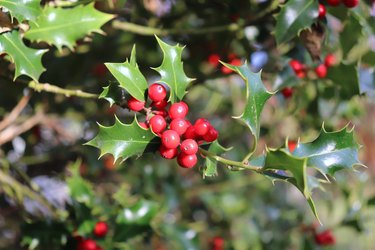
Many holly species won't tolerate winters colder than those found in USDA zone 5, but the blue holly (Ilex × meserveae), often called Meserve holly, is an exception. This hybrid was created as a cross between warmth-loving English holly and cold-tolerant Tsuru holly. It takes its good looks from the English holly but has no problem with zone 3 winters.
The blue holly usually grows no taller than 8 feet but is bushy, offering numerous shiny blue-green holly leaves with toothed margins on purple stems. The flowers are white but mature into showy bright-red berries on female plants in autumn. The berries can last through spring.
Limelight Hydrangea Shrubs
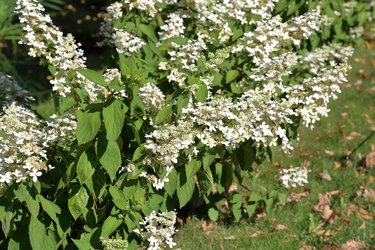
Most gardeners know the utility of hydrangeas, which are large shrubs producing exceptional crops of large blossoms. Limelight hydrangea (Hydrangea paniculata 'Limelight') is no exception, producing a generous supply of huge, pale-green flowers that blush pink and cream as autumn approaches. This tough bush is hardy in USDA zones 3-8 and provides blossoms for months on end.
These deciduous shrubs grow in a rounded shape with large, rich-green leaves and 10-inch flowers. They drop their leaves just before winter when they go dormant. In the lower zones of its range, plant Limelight in a full-sun location.
Japanese Maple
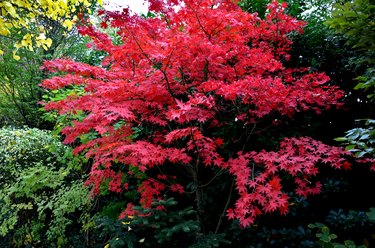
Japanese maples (Acer palmatum) are among a gardener's favorites, with their lacy leaves that light up with fiery colors in autumn. They generally thrive in USDA zones 6 and above. However, there are hybrids available these days that are hardy enough for zone 4 gardens and even perhaps zone 3 if the site is protected. Developers crossed a Japanese maple with a hardier maple, the Korean maple (Acer pseudosieboldianum), to create large bushes or small trees with the Japanese maple's beautifully shaped foliage that are truly cold hardy.
There are several cultivars of this hardy plant that are all excellent for a Japanese garden. Check out North Wind (Acer x pseudosieboldianum 'IsINW'), a tough and beautiful plant. It tops out at 20 feet with a 15-foot spread, but you can keep it smaller with regular trimming.
5 Cold-Weather Flowers
Peonies
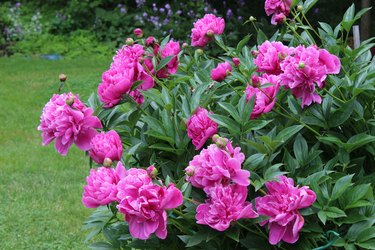
Anyone who has seen the luscious blooms of peonies (Paeonia spp.) might be stunned to learn that the most romantic of all flowers is very cold hardy, surviving even when when the winter temperatures drop in USDA zone 3. Peony plants generally grow up to 3 feet tall and wide, with each stem topped with bright-pink, roselike flowers.
These plants are virtually pest-free, which makes them easy to care for. Plant the bulbs in moist, well-draining soil in an area that gets full sun or partial shade, knowing that they love to pass their dormant period in cold ground.
Alliums
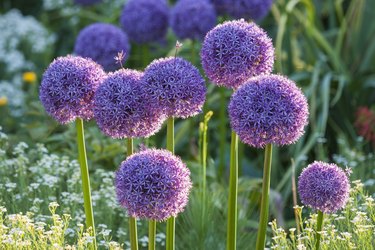
If you want to know what giant alliums look like, think of a photo of fireworks. Alliums are ornamental onions. The beautiful and unusual flowers grow from bulbs, and blooms appear to grace the spring and summer garden. The bulbs should be planted in fall for spring flowers, and they do just fine through the cold winters in USDA zone 4. One to try is Purple Sensation (Allium aflatunense 'Purple Sensation'), offering eye-popping globes of violet flowers up to 5 inches in diameter. They stand tall on 24- to 36-inch stalks.
Hybrid Lenten Rose
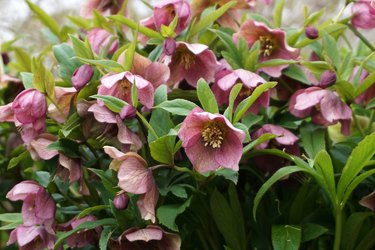
A rose by any other name? Lenten rose (Helleborus x hybridus) is not a rose at all, but its sepals resemble roselike blossoms and appear in late winter/early spring just around the time that some religions celebrate Lent. They last for several months, often February through May. The plant is appreciated for these blooms in purple, red, yellow, green, blue, lavender, and pink as well as for its leathery green foliage.
Hybrid Lenten roses thrive in USDA hardiness zones 4-9. They grow best in partial sunshine in rich, well-draining loam. The plants rise to 18 inches tall and wide and are easy to grow. Plant them on a hillside to appreciate their downward-facing blooms.
Geranium 'Gernic' SUMMER SKIES
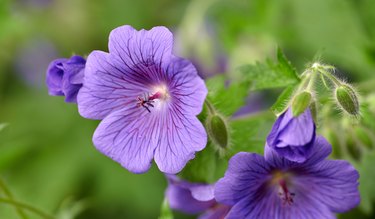
Cranesbill "geraniums" are quite cold hardy, but many find them weedy. For prettier, cold-hardy flowers, try Geranium pratense 'Gernic' SUMMER SKIES, offering double blossoms with attractive veining in a lovely, soft violet-blue. The deeply cut green leaves create a bushy mound. Blossoms appear in late spring in USDA hardiness zones 3-8.
The plants grow to 24 inches high and prefer full sun to partial shade. They are not particular about soil and can grow well in loam, sandy soil, and clay. These geraniums work well in borders and woodland gardens. They can also be considered for containers and make nice cut flowers. They require little care other than irrigation and occasional pruning. Once established, these perennials appear year after year and pretty much take care of themselves.
Coral Bells
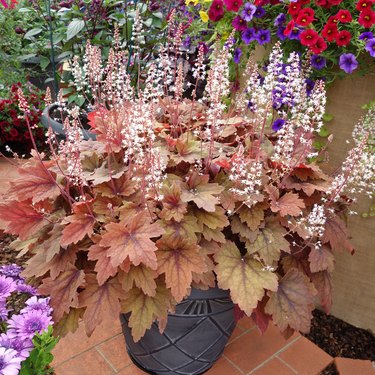
The Coral bell (Heuchera spp.) is an herbaceous perennial that is grown for its flowers and beautiful foliage. Hundreds of varieties are available, offering blossoms in red, white, coral, pink, and orange. Their lobed leaves are evergreen or semievergreen depending on the climate. The foliage is green in the wild, but some cultivars offer leaves in purple, rose, lime, and gold.
A North American native, coral bells form small, lovely, bell-shaped flowers on tall, slender stems. The nectar-rich flowers are a magnet for hummingbirds and butterflies. They can survive cold winters and are hardy in zones 4-8. They are an excellent choice for rock gardens, borders, and containers.
- Happy Sprout: These Are the 21 Best Plants for Cold-Weather Climates
- Perennials.com: Geranium Pratense Summer Skies
- Laidback Gardener: Finally! Japanese Maples for Cold Climates!
- Better Homes & Gardens: 13 Pretty Perennials You Can Count On to Survive Even the Coldest Winters
- Salisbury Greenhouse: 8 Great Groundcovers for Zone 3 Gardens
- The Tree Center: Cold Hardy Holly Bushes
- Better Homes & Gardens: 16 of the Prettiest Allium Varieties to Plant in Your Garden
- Monrovia: Dwarf Alberta Spruce
